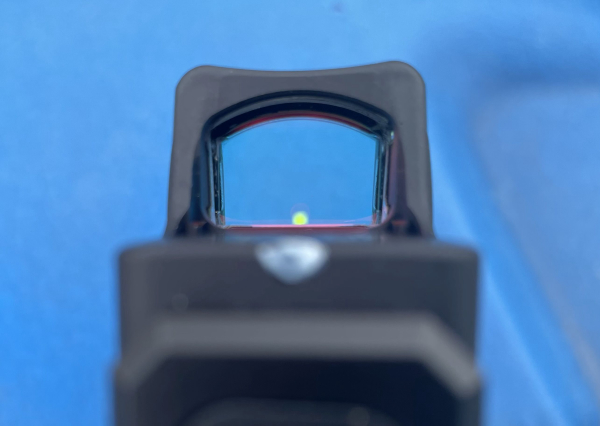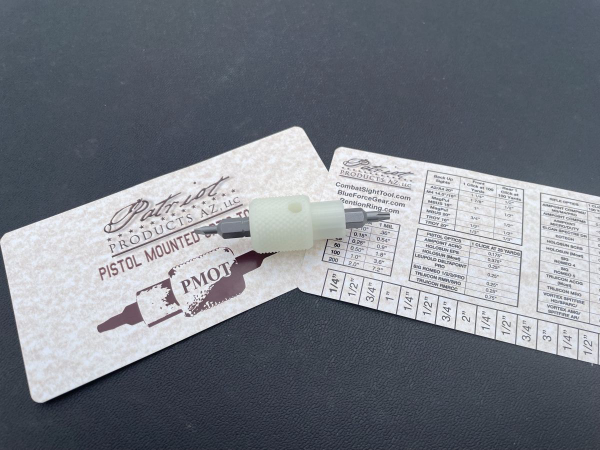In a recent edition of the TACTICAL WIRE, I offered my thoughts on the new Trijicon RMR HD. An improved carry optic based on customer feedback, it’s still a duty pistol-size device.
![]()
Of all the comments and questions I received after the article was published, the most asked was “what carry optic would you use on a compact carry pistol?” Easy answer, folks: the Trijicon RMRcc.
The RMRcc is a compact carry optic designed to be as low profile as possible while maintaining military-grade toughness. I carry this trim package using the Raven Concealment Vanguard trigger guard clip holster.

As you probably guessed, the “cc” in the name stands for “concealed carry.” It’s a compact optic, designed for use on smaller pistols, but offers several larger optic features. Like its big brothers, the RMRcc is built military tough. It will withstand the rigors of combat including being dropped directly on the optic window itself or the pressure of both high and low elevations.
While I’m not convinced that’s necessary for an EDC optic, if you want the additional reassurance, you will get it with this optic.
The RMRcc comes in two versions, one with a 3.25 MOA dot and another with a larger 6.5 MOA dot. While many folks get deep into the weeds over dot size, I’m not one of those people. If I can see it quickly, based on the lighting conditions of the moment, I’m good to go. At that point, I am going to superimpose the dot and depress the trigger.
Sights of all styles have long been something contested by shooters of all ages. Irons versus dots, black sight versus colored sights, tritium versus fiber optic, and so on. I don’t get it. All any sight system does is tell you where the muzzle is pointed. How you wish to receive this information is a personal choice. Pick what works for you and ignore all the outside clutter.
I will be the first to say that carry optics aren’t essential. Cancel me if you want, but I base that statement on centuries of warfare during which iron sights were used quite effectively. That doesn’t mean optics aren’t useful. I choose to use them on my carbine and pistol because they improve my performance. And that’s the best way to choose any piece of gear.

The RMRcc has a thinner, lower-profile design that helps reduce the potential for snagging. Although smaller, the RMRcc maintains all the features of the larger RMR: easy-to-use buttons, an always available 2032 battery with up to four years of illumination (I would change it once a year just to be sure) and a wide variety of mounting plates to fit most popular compact concealed carry pistols.
Other features include a true color, multi-coated lens for wide-band light transmission with minimal change in target area color, easily adjustable windage and elevation knobs, a button lock out mode which secures the auto-brightness setting feature, and complete user brightness settings with eight levels of brightness.
One feature the RMRcc maintains from its bigger brothers is the bottom-loading battery compartment, something that bothers some folks.
While it’s true you should check your zero after removing your RMRcc for a battery change, that does not mean you have to re-zero your unit. It has been my experience that the RMR will retain its zero after a battery change and will only require a round or two to confirm.
Speaking of batteries, this isn’t the place to save a few bucks. When installing a new battery, let me offer you two words of advice — Duracell or Eveready.
I mounted my test RMRcc on a cut slide from Brownells. I’m not a fan of mounting plates, seeing them as a weak point in the mounting process. I don’t even use the battery plate supplied by Trijicon with the unit. I use a small piece of metal right under the battery, between the battery and slide to ensure the battery maintains good contact.
The Brownells slide is nothing fancy, just a conventional slide, rounded at the corners with forward cocking serrations. The Brownells slide fits just like a factory unit with no problems in function after transitioning internal components.

A word on the Brownell’s G43X slide — the optic cut cover plate includes the rear sight dovetail. That means when you remove it to mount your optic, there’s no rear sight dovetail. I solved that by using an Ameriglo front sight colored at the very tip. From the rear, it can be seen just cresting the rear of the optic base. I placed a white dot there. When I align the two, I have a crude back-up sight system that proved to be quite effective out to 10 yards or so.
The slide and optic were mounted to my Glock 43X, a compact pistol I have really come to appreciate. The frame is large enough I can get a solid grip on it, but it’s still easy to conceal.
I use the 15-round Shield magazines which some claim aren’t reliable. This has not been my experience. My stock Shield magazines run and run very reliably. That said, if the Shield magazines didn’t exist, I’d be quite happy with the factory 10-rounders which are trim and easy to carry.
My zeroing process is quite simple: I shoot off-hand at ten yards on a three-inch Post-it note. Once I’m on there, I move back off to twenty-five yards and shoot off hand at a three by five rectangle.
Why off-hand instead of a bench rest? That’s the way I’m going to shoot it for real so it makes sense to me. If I have to make any adjustments at twenty-five yards, I move back to ten to see if my grouping was affected. Once I’m on at both distances, I consider it good and have confidence I can hit at both near and far distances.
While some claim you can’t use a carry optic up close, that hasn’t been my experience. In fact, I find the carry optic easier to use as it glows. And this glowing feature makes the dot easier to find. I like to use some of my up-close movement drills to test any carry optic, primarily my 9 in 9 Drill and the 10 in 8 Drill. Both are shot on three by five rectangles at five yards with the 10 in 8 requiring dynamic lateral movement while drawing.
Both drills require the shooter to stop suddenly and shoot, something I like to test while using any carry optic. If you’re going to lose the dot, this is where it will happen, which means deliberation in its deployment is critical. A consistent path of travel, whether it’s from ready, a manipulation, or from the holster is an essential skill whenever you’re using any carry optic. I can’t stress this enough…be more concerned about the results on the target than the readout on the timer.
While I have several holsters for my 43X, I use the Raven Concealment Vanguard the most. This trigger guard clip IWB “rig” is the trimmest package I’m aware of. No, you can’t re-holster with it, but it carries light and easy, especially under light summer clothing. I carry the 43X/Vanguard on my hip, not forward of the hip and it stays solidly in place.

The Trijicon RMRcc, like the rest of the Trijicon product line, is a tough, reliable unit that will deliver decades of service under very harsh conditions. Yes, it’s a pricey piece of gear, but you will only pay for it once and will likely have it the rest of your life.
Dave Spaulding is a firearms trainer and proprietor of Handgun Combatives. You can see his training videos at YouTube.
